Motivation and Leadership Styles in the Workplace
VerifiedAdded on 2023/06/13
|10
|2847
|279
AI Summary
This article discusses the importance of leadership skills, workplace environment, and human resource management for the success of a business. It explores different leadership styles and motivational tools that can be used to improve employee performance and productivity. The article also includes a summary of research papers on motivation and leadership.
Contribute Materials
Your contribution can guide someone’s learning journey. Share your
documents today.
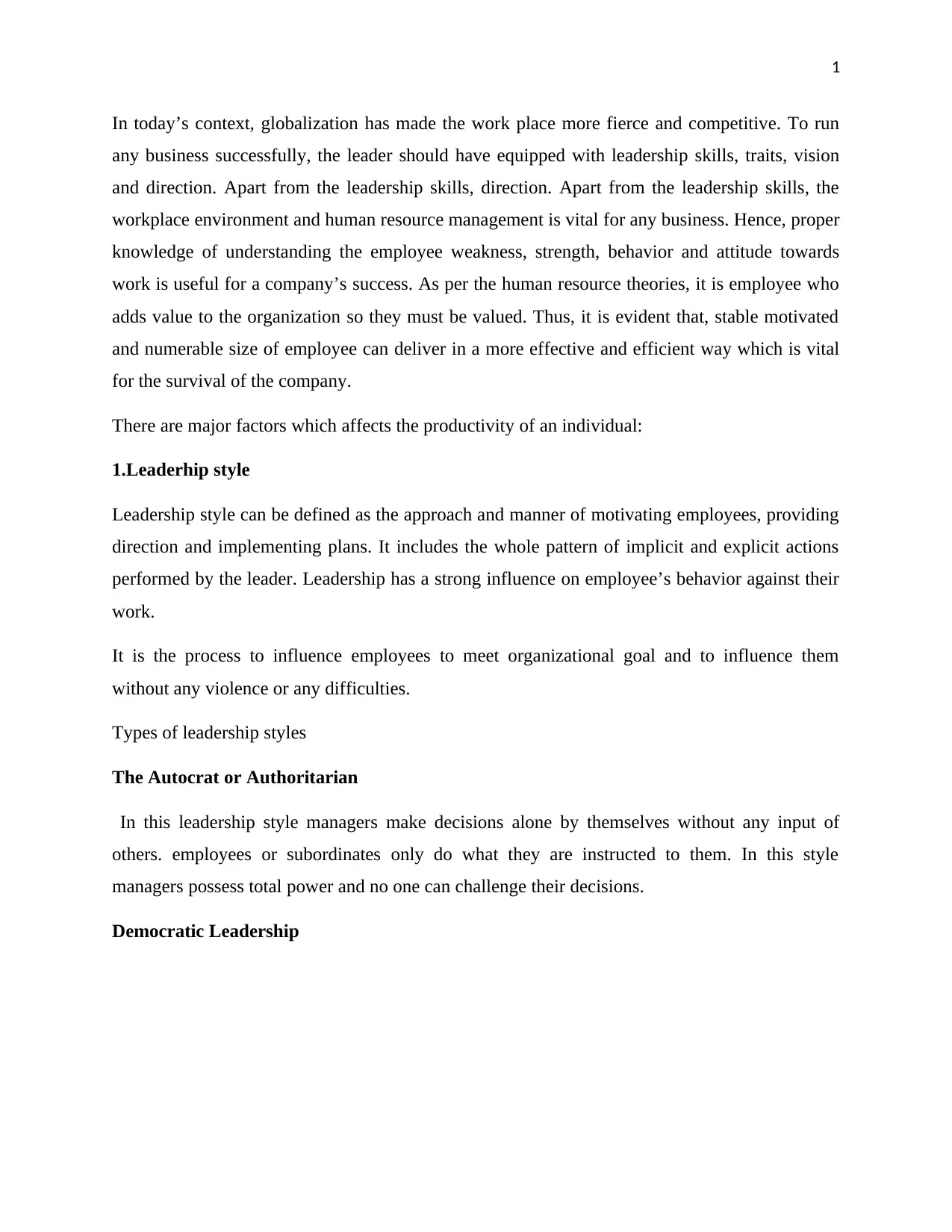
1
In today’s context, globalization has made the work place more fierce and competitive. To run
any business successfully, the leader should have equipped with leadership skills, traits, vision
and direction. Apart from the leadership skills, direction. Apart from the leadership skills, the
workplace environment and human resource management is vital for any business. Hence, proper
knowledge of understanding the employee weakness, strength, behavior and attitude towards
work is useful for a company’s success. As per the human resource theories, it is employee who
adds value to the organization so they must be valued. Thus, it is evident that, stable motivated
and numerable size of employee can deliver in a more effective and efficient way which is vital
for the survival of the company.
There are major factors which affects the productivity of an individual:
1.Leaderhip style
Leadership style can be defined as the approach and manner of motivating employees, providing
direction and implementing plans. It includes the whole pattern of implicit and explicit actions
performed by the leader. Leadership has a strong influence on employee’s behavior against their
work.
It is the process to influence employees to meet organizational goal and to influence them
without any violence or any difficulties.
Types of leadership styles
The Autocrat or Authoritarian
In this leadership style managers make decisions alone by themselves without any input of
others. employees or subordinates only do what they are instructed to them. In this style
managers possess total power and no one can challenge their decisions.
Democratic Leadership
In today’s context, globalization has made the work place more fierce and competitive. To run
any business successfully, the leader should have equipped with leadership skills, traits, vision
and direction. Apart from the leadership skills, direction. Apart from the leadership skills, the
workplace environment and human resource management is vital for any business. Hence, proper
knowledge of understanding the employee weakness, strength, behavior and attitude towards
work is useful for a company’s success. As per the human resource theories, it is employee who
adds value to the organization so they must be valued. Thus, it is evident that, stable motivated
and numerable size of employee can deliver in a more effective and efficient way which is vital
for the survival of the company.
There are major factors which affects the productivity of an individual:
1.Leaderhip style
Leadership style can be defined as the approach and manner of motivating employees, providing
direction and implementing plans. It includes the whole pattern of implicit and explicit actions
performed by the leader. Leadership has a strong influence on employee’s behavior against their
work.
It is the process to influence employees to meet organizational goal and to influence them
without any violence or any difficulties.
Types of leadership styles
The Autocrat or Authoritarian
In this leadership style managers make decisions alone by themselves without any input of
others. employees or subordinates only do what they are instructed to them. In this style
managers possess total power and no one can challenge their decisions.
Democratic Leadership
Secure Best Marks with AI Grader
Need help grading? Try our AI Grader for instant feedback on your assignments.
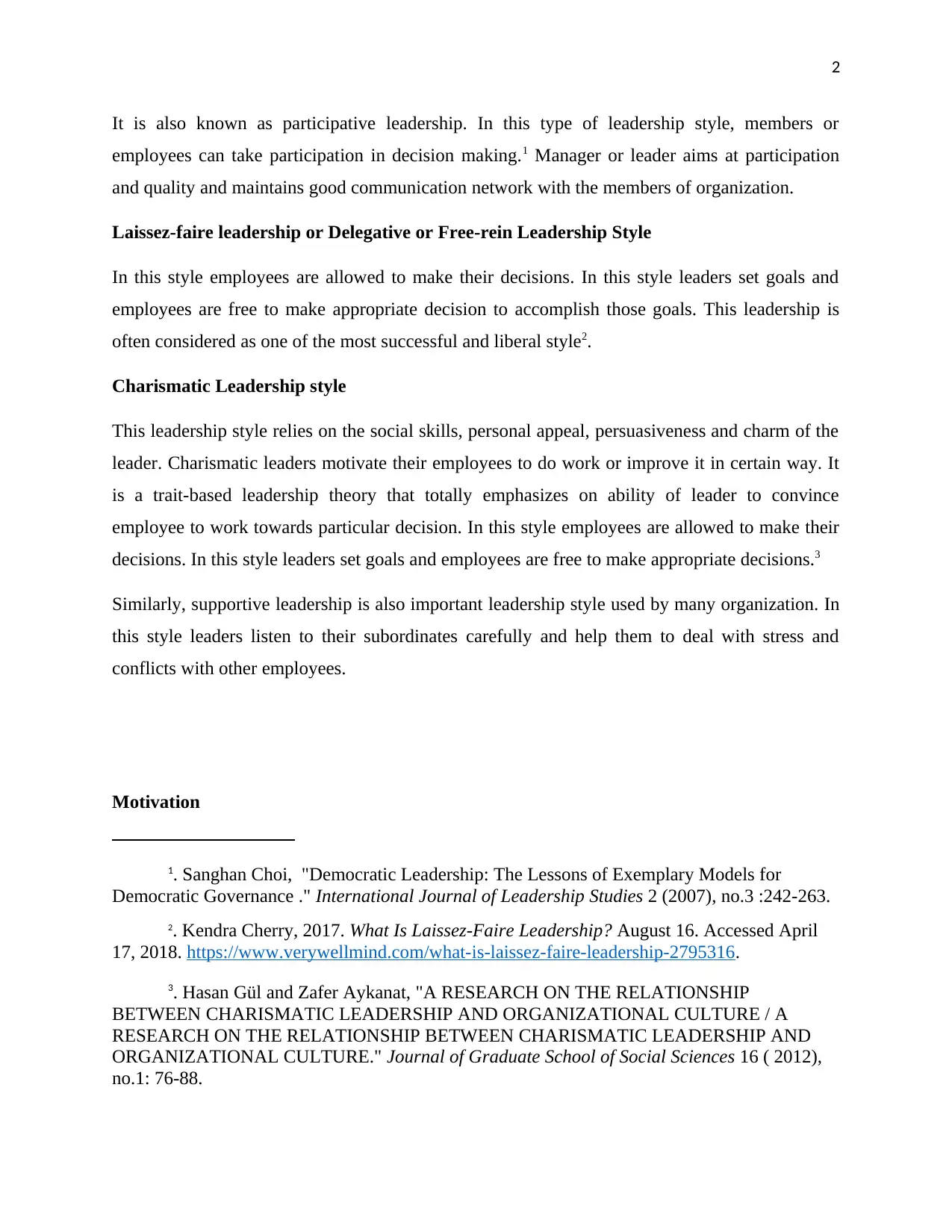
2
It is also known as participative leadership. In this type of leadership style, members or
employees can take participation in decision making.1 Manager or leader aims at participation
and quality and maintains good communication network with the members of organization.
Laissez-faire leadership or Delegative or Free-rein Leadership Style
In this style employees are allowed to make their decisions. In this style leaders set goals and
employees are free to make appropriate decision to accomplish those goals. This leadership is
often considered as one of the most successful and liberal style2.
Charismatic Leadership style
This leadership style relies on the social skills, personal appeal, persuasiveness and charm of the
leader. Charismatic leaders motivate their employees to do work or improve it in certain way. It
is a trait-based leadership theory that totally emphasizes on ability of leader to convince
employee to work towards particular decision. In this style employees are allowed to make their
decisions. In this style leaders set goals and employees are free to make appropriate decisions.3
Similarly, supportive leadership is also important leadership style used by many organization. In
this style leaders listen to their subordinates carefully and help them to deal with stress and
conflicts with other employees.
Motivation
1. Sanghan Choi, "Democratic Leadership: The Lessons of Exemplary Models for
Democratic Governance ." International Journal of Leadership Studies 2 (2007), no.3 :242-263.
2. Kendra Cherry, 2017. What Is Laissez-Faire Leadership? August 16. Accessed April
17, 2018. https://www.verywellmind.com/what-is-laissez-faire-leadership-2795316.
3. Hasan Gül and Zafer Aykanat, "A RESEARCH ON THE RELATIONSHIP
BETWEEN CHARISMATIC LEADERSHIP AND ORGANIZATIONAL CULTURE / A
RESEARCH ON THE RELATIONSHIP BETWEEN CHARISMATIC LEADERSHIP AND
ORGANIZATIONAL CULTURE." Journal of Graduate School of Social Sciences 16 ( 2012),
no.1: 76-88.
It is also known as participative leadership. In this type of leadership style, members or
employees can take participation in decision making.1 Manager or leader aims at participation
and quality and maintains good communication network with the members of organization.
Laissez-faire leadership or Delegative or Free-rein Leadership Style
In this style employees are allowed to make their decisions. In this style leaders set goals and
employees are free to make appropriate decision to accomplish those goals. This leadership is
often considered as one of the most successful and liberal style2.
Charismatic Leadership style
This leadership style relies on the social skills, personal appeal, persuasiveness and charm of the
leader. Charismatic leaders motivate their employees to do work or improve it in certain way. It
is a trait-based leadership theory that totally emphasizes on ability of leader to convince
employee to work towards particular decision. In this style employees are allowed to make their
decisions. In this style leaders set goals and employees are free to make appropriate decisions.3
Similarly, supportive leadership is also important leadership style used by many organization. In
this style leaders listen to their subordinates carefully and help them to deal with stress and
conflicts with other employees.
Motivation
1. Sanghan Choi, "Democratic Leadership: The Lessons of Exemplary Models for
Democratic Governance ." International Journal of Leadership Studies 2 (2007), no.3 :242-263.
2. Kendra Cherry, 2017. What Is Laissez-Faire Leadership? August 16. Accessed April
17, 2018. https://www.verywellmind.com/what-is-laissez-faire-leadership-2795316.
3. Hasan Gül and Zafer Aykanat, "A RESEARCH ON THE RELATIONSHIP
BETWEEN CHARISMATIC LEADERSHIP AND ORGANIZATIONAL CULTURE / A
RESEARCH ON THE RELATIONSHIP BETWEEN CHARISMATIC LEADERSHIP AND
ORGANIZATIONAL CULTURE." Journal of Graduate School of Social Sciences 16 ( 2012),
no.1: 76-88.
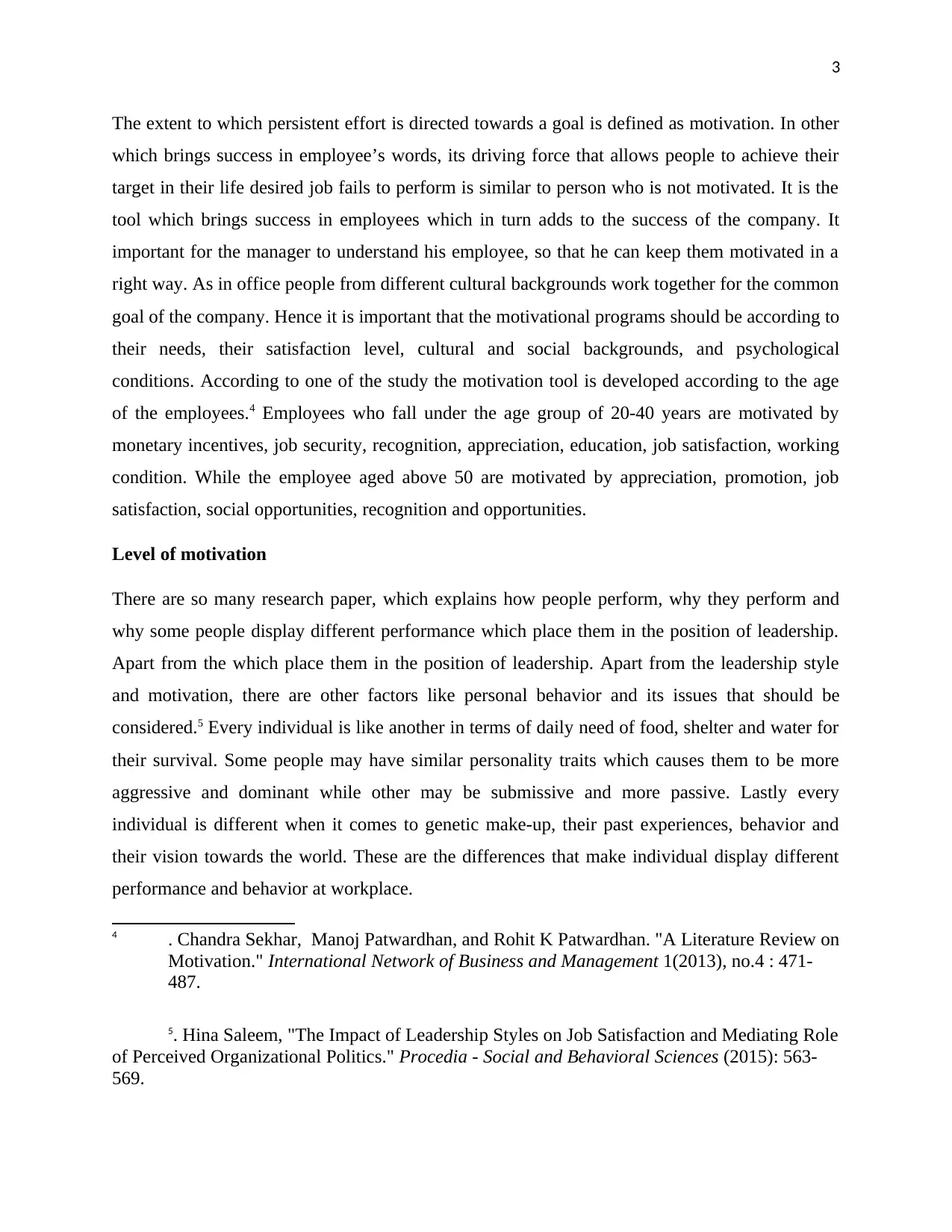
3
The extent to which persistent effort is directed towards a goal is defined as motivation. In other
which brings success in employee’s words, its driving force that allows people to achieve their
target in their life desired job fails to perform is similar to person who is not motivated. It is the
tool which brings success in employees which in turn adds to the success of the company. It
important for the manager to understand his employee, so that he can keep them motivated in a
right way. As in office people from different cultural backgrounds work together for the common
goal of the company. Hence it is important that the motivational programs should be according to
their needs, their satisfaction level, cultural and social backgrounds, and psychological
conditions. According to one of the study the motivation tool is developed according to the age
of the employees.4 Employees who fall under the age group of 20-40 years are motivated by
monetary incentives, job security, recognition, appreciation, education, job satisfaction, working
condition. While the employee aged above 50 are motivated by appreciation, promotion, job
satisfaction, social opportunities, recognition and opportunities.
Level of motivation
There are so many research paper, which explains how people perform, why they perform and
why some people display different performance which place them in the position of leadership.
Apart from the which place them in the position of leadership. Apart from the leadership style
and motivation, there are other factors like personal behavior and its issues that should be
considered.5 Every individual is like another in terms of daily need of food, shelter and water for
their survival. Some people may have similar personality traits which causes them to be more
aggressive and dominant while other may be submissive and more passive. Lastly every
individual is different when it comes to genetic make-up, their past experiences, behavior and
their vision towards the world. These are the differences that make individual display different
performance and behavior at workplace.
4 . Chandra Sekhar, Manoj Patwardhan, and Rohit K Patwardhan. "A Literature Review on
Motivation." International Network of Business and Management 1(2013), no.4 : 471-
487.
5. Hina Saleem, "The Impact of Leadership Styles on Job Satisfaction and Mediating Role
of Perceived Organizational Politics." Procedia - Social and Behavioral Sciences (2015): 563-
569.
The extent to which persistent effort is directed towards a goal is defined as motivation. In other
which brings success in employee’s words, its driving force that allows people to achieve their
target in their life desired job fails to perform is similar to person who is not motivated. It is the
tool which brings success in employees which in turn adds to the success of the company. It
important for the manager to understand his employee, so that he can keep them motivated in a
right way. As in office people from different cultural backgrounds work together for the common
goal of the company. Hence it is important that the motivational programs should be according to
their needs, their satisfaction level, cultural and social backgrounds, and psychological
conditions. According to one of the study the motivation tool is developed according to the age
of the employees.4 Employees who fall under the age group of 20-40 years are motivated by
monetary incentives, job security, recognition, appreciation, education, job satisfaction, working
condition. While the employee aged above 50 are motivated by appreciation, promotion, job
satisfaction, social opportunities, recognition and opportunities.
Level of motivation
There are so many research paper, which explains how people perform, why they perform and
why some people display different performance which place them in the position of leadership.
Apart from the which place them in the position of leadership. Apart from the leadership style
and motivation, there are other factors like personal behavior and its issues that should be
considered.5 Every individual is like another in terms of daily need of food, shelter and water for
their survival. Some people may have similar personality traits which causes them to be more
aggressive and dominant while other may be submissive and more passive. Lastly every
individual is different when it comes to genetic make-up, their past experiences, behavior and
their vision towards the world. These are the differences that make individual display different
performance and behavior at workplace.
4 . Chandra Sekhar, Manoj Patwardhan, and Rohit K Patwardhan. "A Literature Review on
Motivation." International Network of Business and Management 1(2013), no.4 : 471-
487.
5. Hina Saleem, "The Impact of Leadership Styles on Job Satisfaction and Mediating Role
of Perceived Organizational Politics." Procedia - Social and Behavioral Sciences (2015): 563-
569.
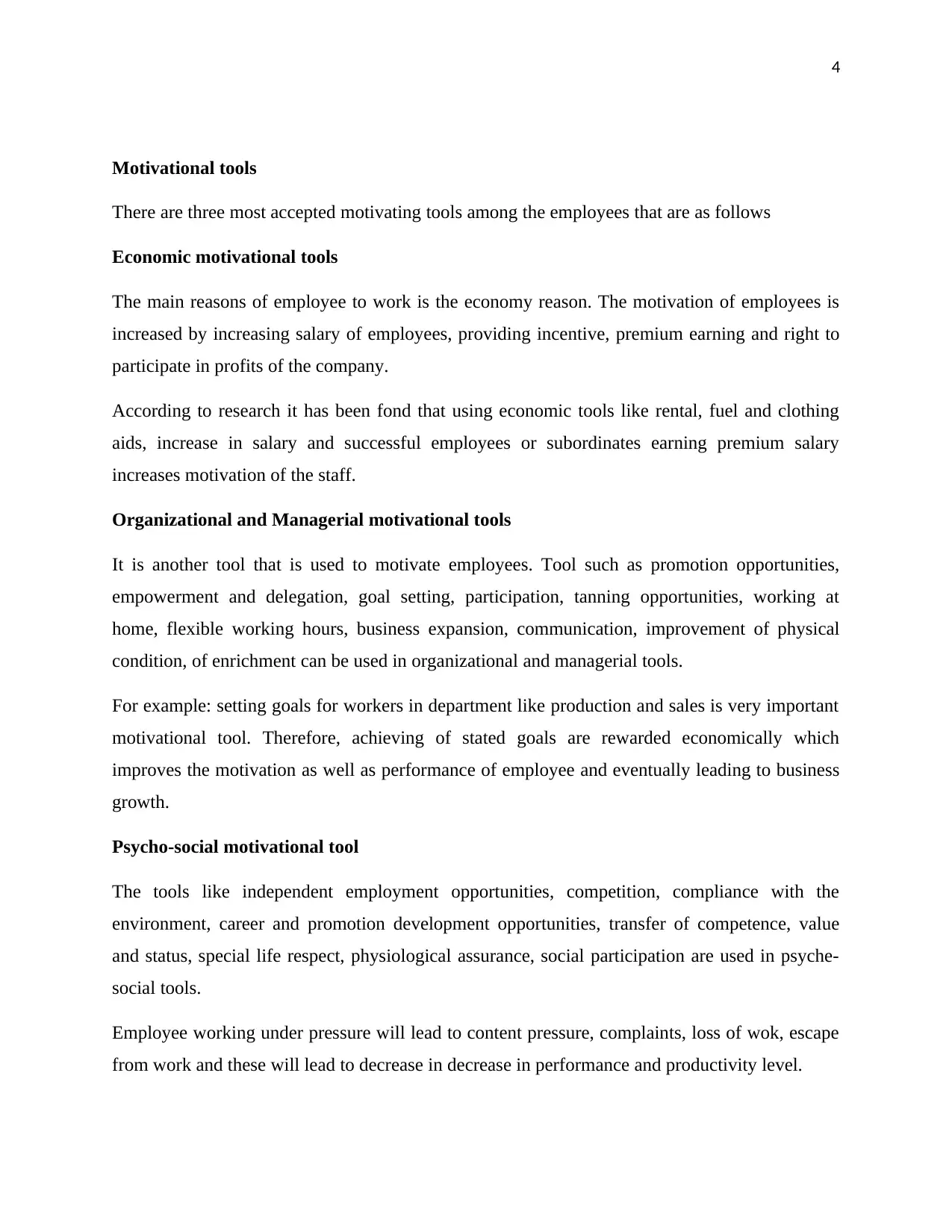
4
Motivational tools
There are three most accepted motivating tools among the employees that are as follows
Economic motivational tools
The main reasons of employee to work is the economy reason. The motivation of employees is
increased by increasing salary of employees, providing incentive, premium earning and right to
participate in profits of the company.
According to research it has been fond that using economic tools like rental, fuel and clothing
aids, increase in salary and successful employees or subordinates earning premium salary
increases motivation of the staff.
Organizational and Managerial motivational tools
It is another tool that is used to motivate employees. Tool such as promotion opportunities,
empowerment and delegation, goal setting, participation, tanning opportunities, working at
home, flexible working hours, business expansion, communication, improvement of physical
condition, of enrichment can be used in organizational and managerial tools.
For example: setting goals for workers in department like production and sales is very important
motivational tool. Therefore, achieving of stated goals are rewarded economically which
improves the motivation as well as performance of employee and eventually leading to business
growth.
Psycho-social motivational tool
The tools like independent employment opportunities, competition, compliance with the
environment, career and promotion development opportunities, transfer of competence, value
and status, special life respect, physiological assurance, social participation are used in psyche-
social tools.
Employee working under pressure will lead to content pressure, complaints, loss of wok, escape
from work and these will lead to decrease in decrease in performance and productivity level.
Motivational tools
There are three most accepted motivating tools among the employees that are as follows
Economic motivational tools
The main reasons of employee to work is the economy reason. The motivation of employees is
increased by increasing salary of employees, providing incentive, premium earning and right to
participate in profits of the company.
According to research it has been fond that using economic tools like rental, fuel and clothing
aids, increase in salary and successful employees or subordinates earning premium salary
increases motivation of the staff.
Organizational and Managerial motivational tools
It is another tool that is used to motivate employees. Tool such as promotion opportunities,
empowerment and delegation, goal setting, participation, tanning opportunities, working at
home, flexible working hours, business expansion, communication, improvement of physical
condition, of enrichment can be used in organizational and managerial tools.
For example: setting goals for workers in department like production and sales is very important
motivational tool. Therefore, achieving of stated goals are rewarded economically which
improves the motivation as well as performance of employee and eventually leading to business
growth.
Psycho-social motivational tool
The tools like independent employment opportunities, competition, compliance with the
environment, career and promotion development opportunities, transfer of competence, value
and status, special life respect, physiological assurance, social participation are used in psyche-
social tools.
Employee working under pressure will lead to content pressure, complaints, loss of wok, escape
from work and these will lead to decrease in decrease in performance and productivity level.
Secure Best Marks with AI Grader
Need help grading? Try our AI Grader for instant feedback on your assignments.

5
Similarly, stats and value change are also important motivational tools for employees. It will
motivate them to work to do their status and position in company. Providing social activities like
picnic events, sport activities, sight-seeing, fun or parties on special occasions at work are
considered as social motivational tools that helps to motivate employees.
Researched paper on motivation and leadership style:
1.According to the research, on the effect of team leader over their employees by Gunduz Aksu
concluded that team leader has significant impact on the performance of the employees6. As per
the survey results 15% of the employees think their team leader rewards their employees, 33.6%
follow their team leader because of his experience and knowledge 47.8% obey the team leader
instructions for the position and 40.7 % believe their achievement has increased their desires.
The survey also concluded that, majority of the employees said that the team leader involved
himself in positive statements on thoughts and his feelings, 38.9% of them thought that the team
leader welcomes change and innovation, 35.4% believed that the team leader is open to
discussion and 44.2% of them believed that their team leader supports them why making
suggestions.
2.As per another study on the motivating factor of the employee by Bayrakci researched the
relationship between managers behavior and employee motivation.7 The total number of
respondents two were 72, out of which 47 were women. Among those respondents, two were
from secondary schools, 6 were from primary schools, 42 of high school and 22 were of them
were university graduates.
The research was based on the relationship between the motivational factors and demographic
variables. It can have concluded that there was no difference in the expectations of employees on
the basis of gender education, age, duration of similar job the motivation expectation was similar
in case of male and females regardless of the literacy level.
6. Gunduz Aksu, "The Impact Of Leaders On Employees Motivation2012." Akademik
Bakış Dergisi Sayı 32, (2012) :1-21
7. Eylem Bayrakci, "The Impact of Leader Behaviours on Employee Motivation."
Süleyman Demirel Üniversitesi Vizyoner Dergisi (2010): 1-21
Similarly, stats and value change are also important motivational tools for employees. It will
motivate them to work to do their status and position in company. Providing social activities like
picnic events, sport activities, sight-seeing, fun or parties on special occasions at work are
considered as social motivational tools that helps to motivate employees.
Researched paper on motivation and leadership style:
1.According to the research, on the effect of team leader over their employees by Gunduz Aksu
concluded that team leader has significant impact on the performance of the employees6. As per
the survey results 15% of the employees think their team leader rewards their employees, 33.6%
follow their team leader because of his experience and knowledge 47.8% obey the team leader
instructions for the position and 40.7 % believe their achievement has increased their desires.
The survey also concluded that, majority of the employees said that the team leader involved
himself in positive statements on thoughts and his feelings, 38.9% of them thought that the team
leader welcomes change and innovation, 35.4% believed that the team leader is open to
discussion and 44.2% of them believed that their team leader supports them why making
suggestions.
2.As per another study on the motivating factor of the employee by Bayrakci researched the
relationship between managers behavior and employee motivation.7 The total number of
respondents two were 72, out of which 47 were women. Among those respondents, two were
from secondary schools, 6 were from primary schools, 42 of high school and 22 were of them
were university graduates.
The research was based on the relationship between the motivational factors and demographic
variables. It can have concluded that there was no difference in the expectations of employees on
the basis of gender education, age, duration of similar job the motivation expectation was similar
in case of male and females regardless of the literacy level.
6. Gunduz Aksu, "The Impact Of Leaders On Employees Motivation2012." Akademik
Bakış Dergisi Sayı 32, (2012) :1-21
7. Eylem Bayrakci, "The Impact of Leader Behaviours on Employee Motivation."
Süleyman Demirel Üniversitesi Vizyoner Dergisi (2010): 1-21
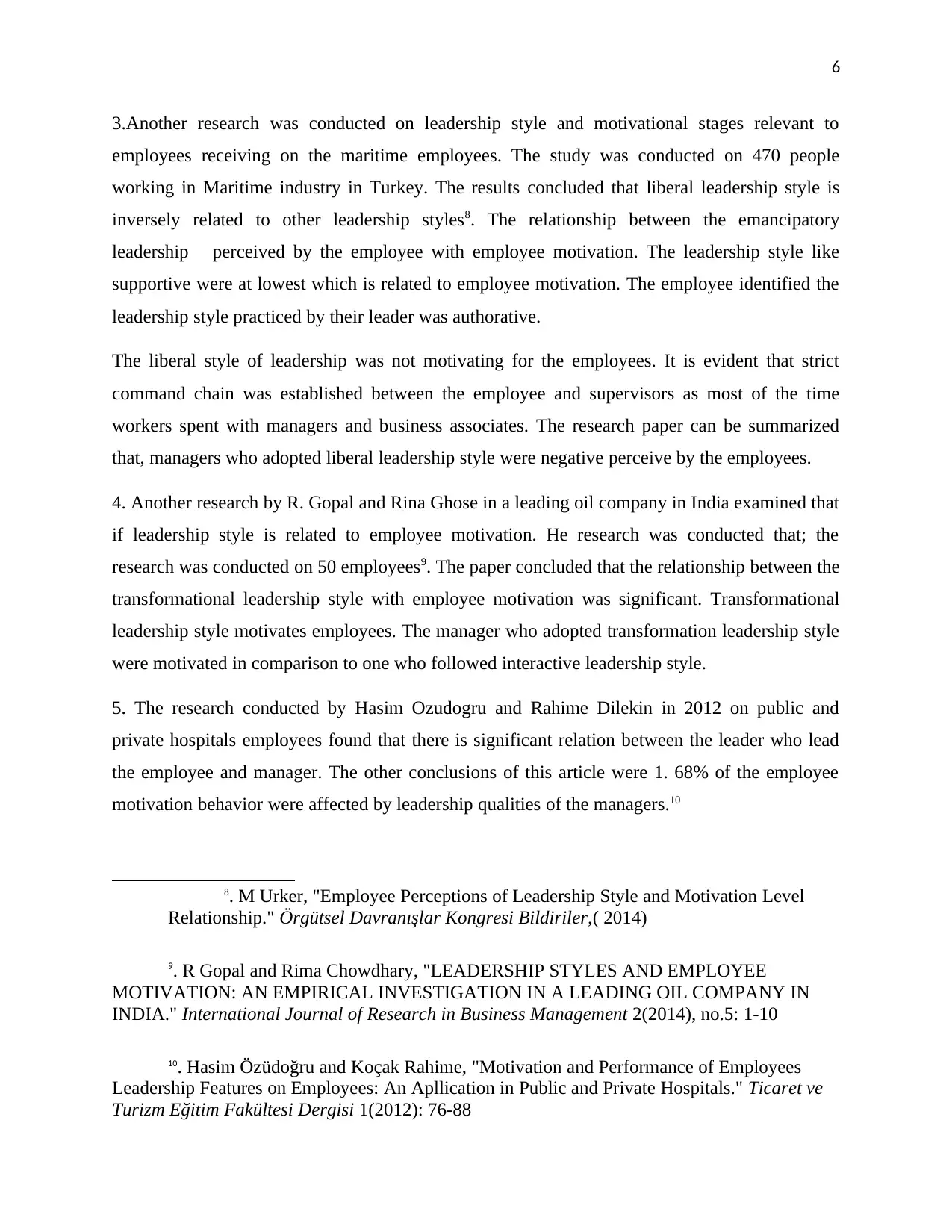
6
3.Another research was conducted on leadership style and motivational stages relevant to
employees receiving on the maritime employees. The study was conducted on 470 people
working in Maritime industry in Turkey. The results concluded that liberal leadership style is
inversely related to other leadership styles8. The relationship between the emancipatory
leadership perceived by the employee with employee motivation. The leadership style like
supportive were at lowest which is related to employee motivation. The employee identified the
leadership style practiced by their leader was authorative.
The liberal style of leadership was not motivating for the employees. It is evident that strict
command chain was established between the employee and supervisors as most of the time
workers spent with managers and business associates. The research paper can be summarized
that, managers who adopted liberal leadership style were negative perceive by the employees.
4. Another research by R. Gopal and Rina Ghose in a leading oil company in India examined that
if leadership style is related to employee motivation. He research was conducted that; the
research was conducted on 50 employees9. The paper concluded that the relationship between the
transformational leadership style with employee motivation was significant. Transformational
leadership style motivates employees. The manager who adopted transformation leadership style
were motivated in comparison to one who followed interactive leadership style.
5. The research conducted by Hasim Ozudogru and Rahime Dilekin in 2012 on public and
private hospitals employees found that there is significant relation between the leader who lead
the employee and manager. The other conclusions of this article were 1. 68% of the employee
motivation behavior were affected by leadership qualities of the managers.10
8. M Urker, "Employee Perceptions of Leadership Style and Motivation Level
Relationship." Örgütsel Davranışlar Kongresi Bildiriler,( 2014)
9. R Gopal and Rima Chowdhary, "LEADERSHIP STYLES AND EMPLOYEE
MOTIVATION: AN EMPIRICAL INVESTIGATION IN A LEADING OIL COMPANY IN
INDIA." International Journal of Research in Business Management 2(2014), no.5: 1-10
10. Hasim Özüdoğru and Koçak Rahime, "Motivation and Performance of Employees
Leadership Features on Employees: An Apllication in Public and Private Hospitals." Ticaret ve
Turizm Eğitim Fakültesi Dergisi 1(2012): 76-88
3.Another research was conducted on leadership style and motivational stages relevant to
employees receiving on the maritime employees. The study was conducted on 470 people
working in Maritime industry in Turkey. The results concluded that liberal leadership style is
inversely related to other leadership styles8. The relationship between the emancipatory
leadership perceived by the employee with employee motivation. The leadership style like
supportive were at lowest which is related to employee motivation. The employee identified the
leadership style practiced by their leader was authorative.
The liberal style of leadership was not motivating for the employees. It is evident that strict
command chain was established between the employee and supervisors as most of the time
workers spent with managers and business associates. The research paper can be summarized
that, managers who adopted liberal leadership style were negative perceive by the employees.
4. Another research by R. Gopal and Rina Ghose in a leading oil company in India examined that
if leadership style is related to employee motivation. He research was conducted that; the
research was conducted on 50 employees9. The paper concluded that the relationship between the
transformational leadership style with employee motivation was significant. Transformational
leadership style motivates employees. The manager who adopted transformation leadership style
were motivated in comparison to one who followed interactive leadership style.
5. The research conducted by Hasim Ozudogru and Rahime Dilekin in 2012 on public and
private hospitals employees found that there is significant relation between the leader who lead
the employee and manager. The other conclusions of this article were 1. 68% of the employee
motivation behavior were affected by leadership qualities of the managers.10
8. M Urker, "Employee Perceptions of Leadership Style and Motivation Level
Relationship." Örgütsel Davranışlar Kongresi Bildiriler,( 2014)
9. R Gopal and Rima Chowdhary, "LEADERSHIP STYLES AND EMPLOYEE
MOTIVATION: AN EMPIRICAL INVESTIGATION IN A LEADING OIL COMPANY IN
INDIA." International Journal of Research in Business Management 2(2014), no.5: 1-10
10. Hasim Özüdoğru and Koçak Rahime, "Motivation and Performance of Employees
Leadership Features on Employees: An Apllication in Public and Private Hospitals." Ticaret ve
Turizm Eğitim Fakültesi Dergisi 1(2012): 76-88
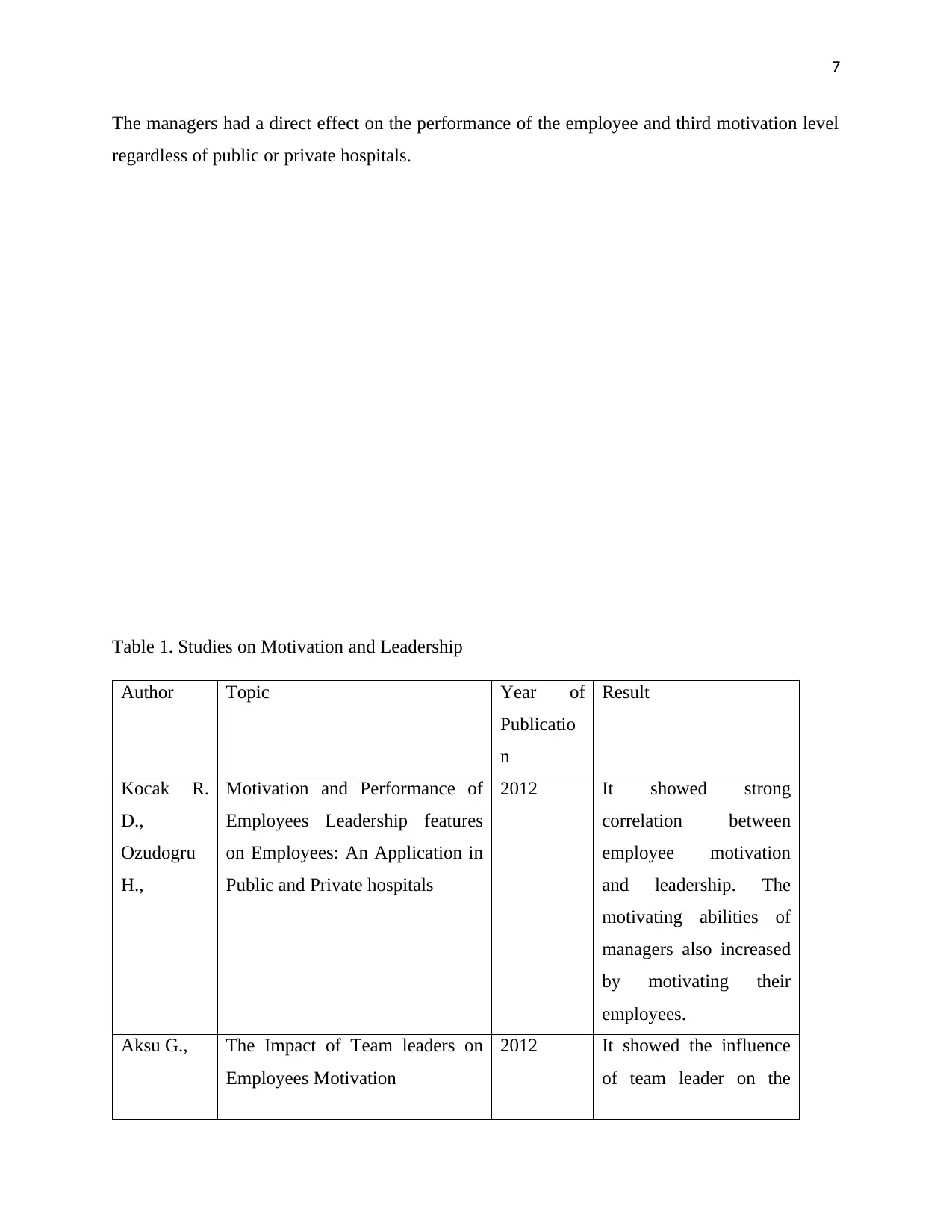
7
The managers had a direct effect on the performance of the employee and third motivation level
regardless of public or private hospitals.
Table 1. Studies on Motivation and Leadership
Author Topic Year of
Publicatio
n
Result
Kocak R.
D.,
Ozudogru
H.,
Motivation and Performance of
Employees Leadership features
on Employees: An Application in
Public and Private hospitals
2012 It showed strong
correlation between
employee motivation
and leadership. The
motivating abilities of
managers also increased
by motivating their
employees.
Aksu G., The Impact of Team leaders on
Employees Motivation
2012 It showed the influence
of team leader on the
The managers had a direct effect on the performance of the employee and third motivation level
regardless of public or private hospitals.
Table 1. Studies on Motivation and Leadership
Author Topic Year of
Publicatio
n
Result
Kocak R.
D.,
Ozudogru
H.,
Motivation and Performance of
Employees Leadership features
on Employees: An Application in
Public and Private hospitals
2012 It showed strong
correlation between
employee motivation
and leadership. The
motivating abilities of
managers also increased
by motivating their
employees.
Aksu G., The Impact of Team leaders on
Employees Motivation
2012 It showed the influence
of team leader on the
Paraphrase This Document
Need a fresh take? Get an instant paraphrase of this document with our AI Paraphraser
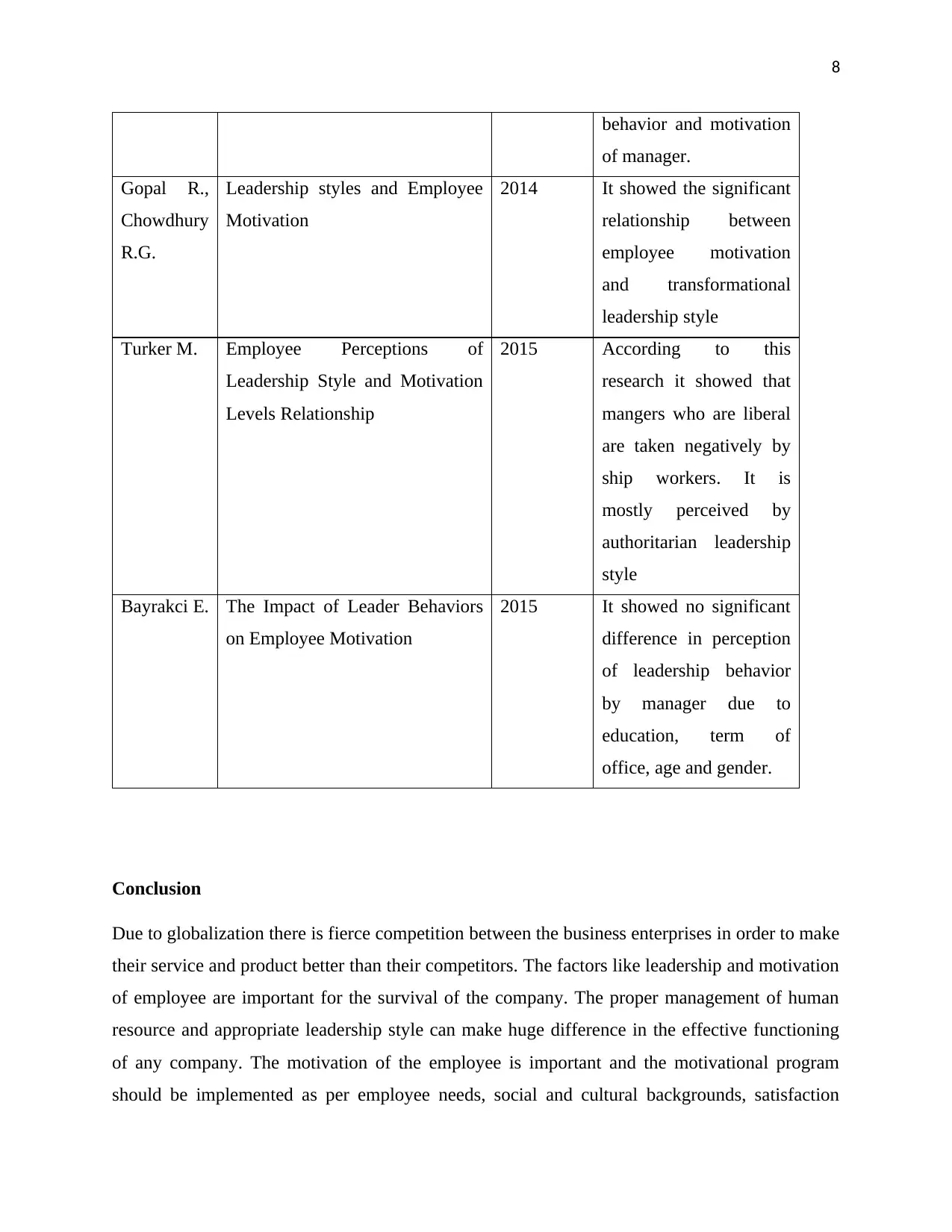
8
behavior and motivation
of manager.
Gopal R.,
Chowdhury
R.G.
Leadership styles and Employee
Motivation
2014 It showed the significant
relationship between
employee motivation
and transformational
leadership style
Turker M. Employee Perceptions of
Leadership Style and Motivation
Levels Relationship
2015 According to this
research it showed that
mangers who are liberal
are taken negatively by
ship workers. It is
mostly perceived by
authoritarian leadership
style
Bayrakci E. The Impact of Leader Behaviors
on Employee Motivation
2015 It showed no significant
difference in perception
of leadership behavior
by manager due to
education, term of
office, age and gender.
Conclusion
Due to globalization there is fierce competition between the business enterprises in order to make
their service and product better than their competitors. The factors like leadership and motivation
of employee are important for the survival of the company. The proper management of human
resource and appropriate leadership style can make huge difference in the effective functioning
of any company. The motivation of the employee is important and the motivational program
should be implemented as per employee needs, social and cultural backgrounds, satisfaction
behavior and motivation
of manager.
Gopal R.,
Chowdhury
R.G.
Leadership styles and Employee
Motivation
2014 It showed the significant
relationship between
employee motivation
and transformational
leadership style
Turker M. Employee Perceptions of
Leadership Style and Motivation
Levels Relationship
2015 According to this
research it showed that
mangers who are liberal
are taken negatively by
ship workers. It is
mostly perceived by
authoritarian leadership
style
Bayrakci E. The Impact of Leader Behaviors
on Employee Motivation
2015 It showed no significant
difference in perception
of leadership behavior
by manager due to
education, term of
office, age and gender.
Conclusion
Due to globalization there is fierce competition between the business enterprises in order to make
their service and product better than their competitors. The factors like leadership and motivation
of employee are important for the survival of the company. The proper management of human
resource and appropriate leadership style can make huge difference in the effective functioning
of any company. The motivation of the employee is important and the motivational program
should be implemented as per employee needs, social and cultural backgrounds, satisfaction

9
levels, psychological needs. The manager who understands his employee can launch motivation
program specific to employee.
All the research conducted above concluded that there is significant impact of leadership style of
the manager motivation of their employee. Hence, it can be said that working style of leaders
have direct impact on the performance of his employees. Although all the studies conducted
above do not provide concrete interpretation due to limited size of the respondents, firm but
majority of studies had a positive outcome.
References
Aksu, Gunduz. 2012. "The Impact Of Leaders On Employees Motivation2012." Akademik Bakış
Dergisi Sayı 32 :1-21.
Bayrakci, Eylem. 2010. "The Impact of Leader Behaviours on Employee Motivation." Süleyman
Demirel Üniversitesi Vizyoner Dergisi 1-21.
Cherry, Kendra. 2017. What Is Laissez-Faire Leadership? August 16. Accessed April 17, 2018.
https://www.verywellmind.com/what-is-laissez-faire-leadership-2795316.
Choi, Sanghan. 2007. "Democratic Leadership: The Lessons of Exemplary Models for
Democratic Governance ." International Journal of Leadership Studies 2, no.3 :242-263.
Gopal, R, and Rima Chowdhary. 2014. "LEADERSHIP STYLES AND EMPLOYEE
MOTIVATION: AN EMPIRICAL INVESTIGATION IN A LEADING OIL
COMPANY IN INDIA." International Journal of Research in Business Management 2,
no.5: 1-10.
Gül, Hasan, and Zafer Aykanat. 2012. "A RESEARCH ON THE RELATIONSHIP BETWEEN
CHARISMATIC LEADERSHIP AND ORGANIZATIONAL CULTURE / A
RESEARCH ON THE RELATIONSHIP BETWEEN CHARISMATIC LEADERSHIP
AND ORGANIZATIONAL CULTURE." Journal of Graduate School of Social Sciences
16, no.1: 76-88.
levels, psychological needs. The manager who understands his employee can launch motivation
program specific to employee.
All the research conducted above concluded that there is significant impact of leadership style of
the manager motivation of their employee. Hence, it can be said that working style of leaders
have direct impact on the performance of his employees. Although all the studies conducted
above do not provide concrete interpretation due to limited size of the respondents, firm but
majority of studies had a positive outcome.
References
Aksu, Gunduz. 2012. "The Impact Of Leaders On Employees Motivation2012." Akademik Bakış
Dergisi Sayı 32 :1-21.
Bayrakci, Eylem. 2010. "The Impact of Leader Behaviours on Employee Motivation." Süleyman
Demirel Üniversitesi Vizyoner Dergisi 1-21.
Cherry, Kendra. 2017. What Is Laissez-Faire Leadership? August 16. Accessed April 17, 2018.
https://www.verywellmind.com/what-is-laissez-faire-leadership-2795316.
Choi, Sanghan. 2007. "Democratic Leadership: The Lessons of Exemplary Models for
Democratic Governance ." International Journal of Leadership Studies 2, no.3 :242-263.
Gopal, R, and Rima Chowdhary. 2014. "LEADERSHIP STYLES AND EMPLOYEE
MOTIVATION: AN EMPIRICAL INVESTIGATION IN A LEADING OIL
COMPANY IN INDIA." International Journal of Research in Business Management 2,
no.5: 1-10.
Gül, Hasan, and Zafer Aykanat. 2012. "A RESEARCH ON THE RELATIONSHIP BETWEEN
CHARISMATIC LEADERSHIP AND ORGANIZATIONAL CULTURE / A
RESEARCH ON THE RELATIONSHIP BETWEEN CHARISMATIC LEADERSHIP
AND ORGANIZATIONAL CULTURE." Journal of Graduate School of Social Sciences
16, no.1: 76-88.

10
Özüdoğru, Hasim, and Koçak Rahime. 2012. "Motivation and Performance of Employees
Leadership Features on Employees: An Apllication in Public and Private Hospitals."
Ticaret ve Turizm Eğitim Fakültesi Dergisi 1: 76-88.
Saleem, Hina. 2015. "The Impact of Leadership Styles on Job Satisfaction and Mediating Role of
Perceived Organizational Politics." Procedia - Social and Behavioral Sciences : 563-569.
Sekhar, Chandra, Manoj Patwardhan, and Rohit K Patwardhan. 2013. "A Literature Review on
Motivation." International Network of Business and Management 1, no.4 : 471-487.
Türker, M. 2014. "Employee Perceptions of Leadership Style and Motivation Level
Relationship." Örgütsel Davranışlar Kongresi Bildiriler.
Özüdoğru, Hasim, and Koçak Rahime. 2012. "Motivation and Performance of Employees
Leadership Features on Employees: An Apllication in Public and Private Hospitals."
Ticaret ve Turizm Eğitim Fakültesi Dergisi 1: 76-88.
Saleem, Hina. 2015. "The Impact of Leadership Styles on Job Satisfaction and Mediating Role of
Perceived Organizational Politics." Procedia - Social and Behavioral Sciences : 563-569.
Sekhar, Chandra, Manoj Patwardhan, and Rohit K Patwardhan. 2013. "A Literature Review on
Motivation." International Network of Business and Management 1, no.4 : 471-487.
Türker, M. 2014. "Employee Perceptions of Leadership Style and Motivation Level
Relationship." Örgütsel Davranışlar Kongresi Bildiriler.
1 out of 10
Related Documents
Your All-in-One AI-Powered Toolkit for Academic Success.
+13062052269
info@desklib.com
Available 24*7 on WhatsApp / Email
![[object Object]](/_next/static/media/star-bottom.7253800d.svg)
Unlock your academic potential
© 2024 | Zucol Services PVT LTD | All rights reserved.




